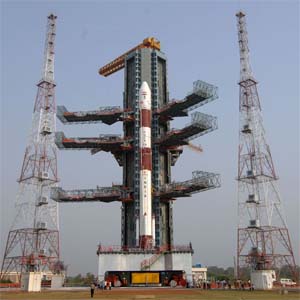Countdown Begins For PSLV-C15 Launch
 The countdown for the 17th flight launch of Indian space agency's Polar Satellite Launch Vehicle PSLV rocket carrying five satellites, comprising a cartography one for land mapping and information, started today at the rocket port Sriharikota.
The countdown for the 17th flight launch of Indian space agency's Polar Satellite Launch Vehicle PSLV rocket carrying five satellites, comprising a cartography one for land mapping and information, started today at the rocket port Sriharikota.
The 44-metre tall PSLV is a four-stage rocket, which is powered by solid and liquid propellants alternatively.
S. Satish, director at the Indian Space Research Organisation (ISRO), said, "Everything is going smoothly and we are getting ready for the Monday launch. The 50 hours, 30 minutes countdown started at 6.52 a. m. Saturday."
The rocket will blast off into space from Sriharikota containing the 694 kg Cartosat 2B and an Algerian satellite, Alsat (117 kg).
It will also take 3 very small satellites including NLS 6.1 and NLS 6.2 from Canada and Switzerland, and StudSat formulated by students of engineering colleges in Bangalore and Hyderabad.
The first and third phases of the rocket are fired by solid propellant and the second and fourth stages are fired by liquid propellant.
According to ISRO representatives, the solid fuel stages are cast ready whereas the liquid fuel - Unsymmetrical Di-Methyl Hydrazine (UDMH) as fuel and Nitrogen tetroxide (N2O4) as oxidiser - will be filled hours before the blast off.
The rocket's main cargo Cartosat-2B is a remote sensing satellite, which carries a sophisticated panchromatic camera on board to photograph specific spots closely. The pics are useful for cartographic applications such as mapping, land information and geographical information system.
Cartosat- 2B will join the other two cartography satellites Cartosat- 2 and 2A launched earlier. With three satellites ISRO's satellites can cover the country effectively.
ISRO has been carrying out multiple launches for several years. In 2008 it set a world record launching 10 satellites at one go.
Originally scheduled for launch May 9, ISRO decided to postpone the launch as it found "a marginal drop in the pressure in the second stage of the vehicle during mandatory checks" due to a faulty valve.
At that time the rocket was almost ready except for the loading of the satellites.
As the faulty valve was in an inaccessible area with the rocket stages having been fully assembled, the second stage had to be dismantled to take corrective action.
Even after the replacement of the faulty valve at Sriharikota the problem continued to persist and ISRO sent the second stage (engine and other systems) back to its assembly centre. (With Inputs from Agencies)